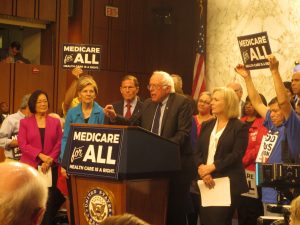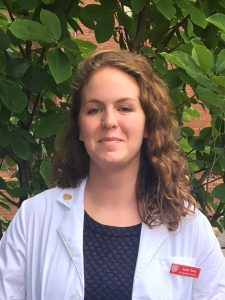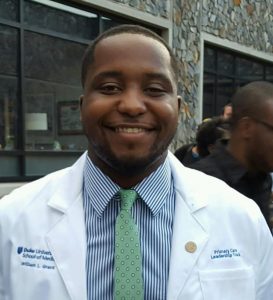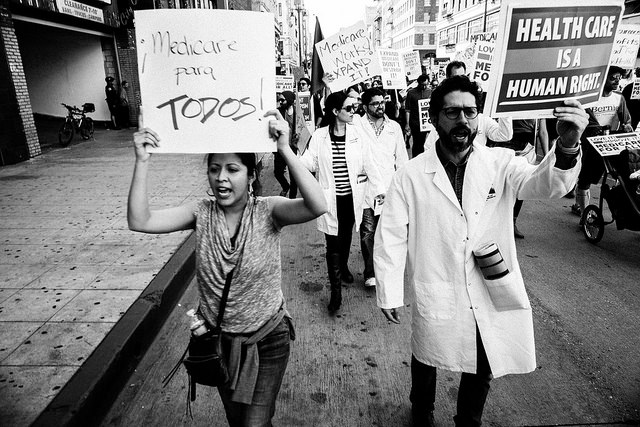This article originally appeared on Common Dreams. You can read the original post here.
“Despite continued assertions that universal healthcare in the United States is merely a liberal “pipe dream,” public support is growing.”
In the face of a fiercely conservative administration, 2017 has seen an upsurge in popular resistance against measures that threatened to chip away at important–if imperfect–social welfare initiatives, chief among them the ability for Americans to receive quality healthcare.
Activists pushed back against a series of attempts by Republican lawmakers to repeal and replace the Affordable Care Act (ACA) with bills that the Congressional Budget Office estimated would have led to the loss of health coverage for 22 to 23 million Americans.
While it is tempting to remain on the defensive in the face of an agenda that would rob us of our healthcare, citizen activists across the country recognize that merely protecting the ACA would continue to leave the most marginalized populations in this country behind. While many Americans continue to receive health coverage under the ACA, an estimated 28 million remain uninsured and medical bills continue to be the leading cause of bankruptcy in the United States.
According to a national survey conducted by the Pew Research Center, 60 percent of the population believe that the federal government has a responsibility to provide health coverage for all Americans. Despite continued assertions that universal healthcare in the United States is merely a liberal “pipe dream,” a Medicare-for-All health program–a healthcare insurance system that is government-run–remains the best option for ensuring that all Americans have access to quality healthcare.
“Overall,” the report stated, “33 percent of the public now favors such a ‘single payer’ approach to health insurance, up 5 percentage points since January and 12 points since 2014.”
Speaking to a crowd at his church in Plains, Georgia, former President Jimmy Carter prophesied that the U.S. would one day adopt a single-payer health system. And while there are millions of stories of individuals and families who struggle daily for adequate healthcare, and though these stories indicate a health system that remains in the service of profits over patients, 2017 should nonetheless give hope to patients and advocates in the fight for universal healthcare.
Here are some of the highlights.
1. Legislative support surges for Medicare-for-All bill in the House.
House Bill 676 currently has 120 co-sponsors–up from just 49 legislators in 2015. During a spate of attempts by Republican lawmakers to scrap Obama’s signature health law, Democrats needed an alternative plan that would offer a way forward. Enter H.B. 676. Single-payer supporters such as Physicians for a National Health Program (PNHP) and National Nurses United (NNU) have long heralded the bill as being the most comprehensive single-payer legislation to date. Representative John Conyers of Michigan has introduced the single-payer legislation in every congress since 2003. Recently, Conyers agreed to resign his seat due to multiple charges of sexual harassment. His behavior is abhorrent and demands investigation and prosecution. It also serves as a harsh reminder to the movement that universal healthcare will not be won by the stroke of a lawmaker’s pen. Indeed, the movement is, at its core, a call for redistribution of the power and wealth that serves to protect men like this. The people’s vision of Medicare for All is much greater than a single man in power, it is the collective vision of a grassroots, broad-based coalition of activists and advocates.
 2. The Women’s March brings millions into the streets in defense of human rights.
2. The Women’s March brings millions into the streets in defense of human rights.
The day following President Trump’s inauguration became the largest single-day demonstration in American history. The Women’s March was championed by women committed to an intersectional platform of justice and on January 21st, 2017, demonstrators across the globe called for a dismantling of systems of oppression. While single-payer healthcare was not in the guiding principles put forth by the march’s organizers, the emphasis on the importance of intersectionality in the fight justice should embolden healthcare advocates to re-envision universal healthcare through the lens of social and racial justice. Healthcare for all is a basic assertion of every person’s human right to health and wellness.

3. Senator Bernie Sanders unveils the Medicare-for-All Act of 2017.
Amidst a seemingly endless stream of bills promising to repeal and replace Obamacare, Sanders put forth an alternative plan to improve and expand Medicare for all Americans. Sixteen other senators stood alongside Sanders when he introduced Senate Bill 1804, which represented a central and popular platform of his 2016 campaign. Despite garnering the support of several potential Democratic candidates for the 2020 presidential election, others on the left extolled the plan as being unrealistic or inopportune. The gains in popularity among Democrats prompted pundit Bill Scher to proclaim, “The Democratic Party now is, for all intents and purposes, the party of single-payer health insurance.” And it is a big mistake, he said. In this way, the latest attempt to pass universal health coverage mirrors its 100-year history with advocates besieged from members of the media as well as elected officials on both the right and the left. Sanders readily admitted that the bill was doomed to fail in the Republican-controlled legislature, but it represents an important marker in changing attitudes in the U.S. towards universal healthcare.
4. The opioid epidemic continues to rage with the National Center for Health Statistics reporting that 64,000 Americans died from opioids in 2016.
Although Trump declared the opioid epidemic a “public health emergency,” he refused to allocate funds to fight the onslaught of overdoses occurring around the country, despite a one-year death toll that exceeds the number of total American deaths in the Vietnam War. We already know that rampant profiteering by the pharmaceutical industry and over-prescribing by some physicians were key factors in fueling this epidemic. Thanks to a report released this year by The New York Times and ProPublica, we now know that insurance companies played a role, too, by limiting access to safer, and costlier, pain management options. Chronic pain treatment is a relatively new area of medicine and often requires long-term treatment and coordination between physicians, physical therapists, social workers, and other members of the healthcare team, something our current health system is ill-equipped to carry out. Eradicating such a devastating and widespread epidemic will only happen by implementing a healthcare system that is not hamstrung by the whims of party politics or health insurance companies but instead one that provides people with substance abuse disorders rehabilitative treatment that is scientifically proven, and allows physicians the freedom to provide their patients with this effective care.
5. While continuing to wage war on Obamacare, Trump lauds Australia for having “better” healthcare–which happens to be a single-payer system.
Speaking to the press alongside the president of Australia, Trump admitted, “We have a failing health care — I shouldn’t say this to our great gentleman and my friend from Australia, because you have better healthcare than we do.” This isn’t the first time that Trump endorsed single payer. Unfortunately, his actions paint a different picture. In the wake of the legislature’s failure to drive a stake in the ACA, Trump made good on his campaign promise to thwart the healthcare program by cutting funding for enrollment groups to enroll individuals into the program and slashing money allocated for enrollment advertising. A recent Gallup poll showed an uptick in the number of people without insurance, reinforcing the need for an improved Medicare-for-All system that can provide us with real, long-lasting health reform.
6. “Tom, you’re fired.” Health and Human Secretary Tom Price resigns amidst public outrage about his use of at least $400,000 in taxpayer money for travel expenses on privately chartered flights.
Although the first-class joyrides were the death knell for the former orthopedic surgeon and U.S. Representative, Price began his short tenure in the sights of activists who questioned his commitment towards advocating for the healthcare of all Americans. A member of the Association of American Physicians and Surgeons which is devoted to maintaining a free-market healthcare system, Price pushed to replace the ACA with a $1,200 per year tax-credit system that people could use to pay for a small percentage of their health insurance. This is in addition to Price’s stance against stem cell research, his belief that life begins at conception, and his lack of support for equal protections for lesbian, gay, bisexual, and transgender people. The Stop Price campaign was just one of many ways that healthcare advocates, including physicians and medical students, pointed a spotlight on the Trump administration’s close ties to powerful health insurance and pharmaceutical companies. Another successful campaign pressured the Cleveland Clinic to cancel its annual fundraising gala at Trump’s Mar-a-Lago club. Opposition is already being mobilized against Alex Azar, Trump’s pick to replace Price, who was a former president at the pharmaceutical giant, Eli Lilly.
7. The student section of the American Medical Association (AMA) passes a resolution in support of single-payer healthcare and calls on the AMA to rescind its 170-year opposition towards single-payer healthcare.
This powerful resolution was no easy sell, given the clout and history of the AMA. Although membership has steadily declined since the 1950s, the AMA remains the most powerful physicians’ organization in the country, ranking number four among the top 50 lobbying organizations of 2016. The association’s weekly publication, the Journal of the American Medical Association (JAMA), also holds great influence within the medical community. Historically, the AMA opposed expansive social programs during the 20th Century, from Social Security to President Truman’s national health insurance plan to Medicare and Medicaid. The Medical Student Section isn’t the first student arm of the AMA. Members of the AMA’s first student organization, the Student American Medical Association (SAMA), fled the organization in 1967 because of their opposition to the Vietnam War and because they supported issues that the AMA refused to embrace or actively thwarted like civil rights and universal healthcare. The group later changed their name to the American Medical Student Association (AMSA) and its members continue to promote universal healthcare. Meanwhile, members of the Medical Student Section, formed in 1979, continue to work under the auspices of the AMA to change the organization from the inside. “We hope that the passage of this resolution can show that with enough time, teamwork, effort, and organizing, even the most powerful healthcare organizations can come around to single payer,” said Brad Zehr, a member of the AMA-MSS. The resolution will be debated at the AMA’s annual meeting next year in Chicago.

8. In the face of a conservative administration that will undoubtedly quash federal universal healthcare legislation during the next three years, campaigns for state-based single payer healthcare gain steam.
These movements are invariably met with the question: If it didn’t work in Vermont and Colorado, why will it work here? Indeed, the failures in these states are a considerable setback in the movement for state single payer healthcare. While there are certainly barriers to implementing universal healthcare for states, there are no reasons to believe that it couldn’t happen once organizers have built the political will. Further, once a state can implement such a system, organizers hope it will serve as evidence for why a federal single payer system could thrive.
In New York, The New York Health Act (A. 4738 / S. 4840) passed the Assembly 92 to 52. A study shows that the bill would save 98% of New Yorkers money on the healthcare when compared to a policy through their employer or the marketplace. The bill now only needs one state senator to pass in the senate.
In California, grassroots education campaigns have shifted the popular opinion on universal healthcare, with now 70% of Californians supporting state single payer legislation. SB 562 or the Healthy California Act passed the state senate in June.
In Massachusetts, an amendment was adopted by the state Senate as part of a larger healthcare reform bill. The amendment charges the state to measure the impact that a single payer system would have on the cost and delivery of healthcare in Massachusetts. Should it prove to save costs when compared to current state spending, the legislature would be required to state the process of enacting a single payer plan.
In Vermont, organizers refocused after a devastating 2014 political abandonment by Governor Shumlin of Act 48 after its passage. Now organizers are looking at a more political feasible option: primary care for all; bills S53 and H248 have been introduced with tri-partisan support. The hope is that a plan like this would slowly be expanded to cover all sectors of healthcare.
 Jonathan Michels is a freelance journalist and a premedical student based in Winston-Salem, North Carolina. He is a member of the media team for Students for a National Health Program.
Jonathan Michels is a freelance journalist and a premedical student based in Winston-Salem, North Carolina. He is a member of the media team for Students for a National Health Program.
 Armide Storey is a medical student at Boston University School of Medicine. She is particularly interested in understanding health as it intersects with class, race, ability, sexuality, and gender.
Armide Storey is a medical student at Boston University School of Medicine. She is particularly interested in understanding health as it intersects with class, race, ability, sexuality, and gender.



 The Trump administration’s recent announcement to end the Deferred Action for Childhood Arrivals (DACA) program instilled fear and outrage in communities across the country. As a medical student with friends and classmates with DACA status, I am particularly disappointed in the poor and compassionless judgment of our nation’s leader. I fear for my peers who have worked incredibly hard and overcome the most daunting of obstacles to get where they are today, and who now could see it all taken away from them. Their now tenuous situation is unimaginable to me. But I also fear the impact of this decision on my non-DACA classmates, on our training, and on our futures. There is certainly a moral case to keep DACA alive, but the effects of its repeal on the healthcare system writ large make apparent that it’s also a bad idea for all Americans.
The Trump administration’s recent announcement to end the Deferred Action for Childhood Arrivals (DACA) program instilled fear and outrage in communities across the country. As a medical student with friends and classmates with DACA status, I am particularly disappointed in the poor and compassionless judgment of our nation’s leader. I fear for my peers who have worked incredibly hard and overcome the most daunting of obstacles to get where they are today, and who now could see it all taken away from them. Their now tenuous situation is unimaginable to me. But I also fear the impact of this decision on my non-DACA classmates, on our training, and on our futures. There is certainly a moral case to keep DACA alive, but the effects of its repeal on the healthcare system writ large make apparent that it’s also a bad idea for all Americans. “Dreamers” are our friends, our peers, our lab partners, and our teachers. What we can learn from them can’t be learned from a book or a computer, but what they can teach us will make us better doctors. In more ways than one, they make our healthcare system – and our country – stronger.
“Dreamers” are our friends, our peers, our lab partners, and our teachers. What we can learn from them can’t be learned from a book or a computer, but what they can teach us will make us better doctors. In more ways than one, they make our healthcare system – and our country – stronger.
 Vidya Visvabharathy is a graduate student in Public Health with a concentration in Maternal and Child Health Epidemiology at the University of Illinois at Chicago.
Vidya Visvabharathy is a graduate student in Public Health with a concentration in Maternal and Child Health Epidemiology at the University of Illinois at Chicago.


